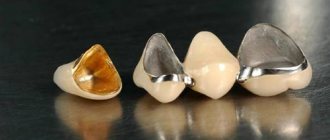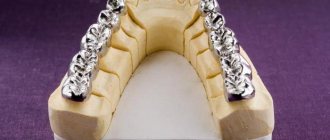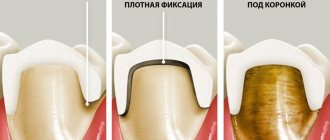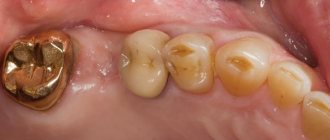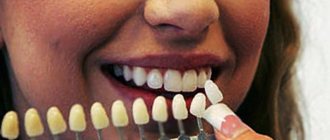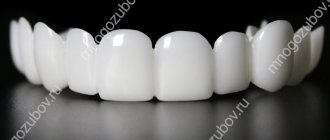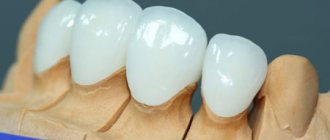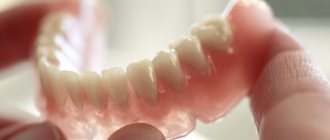Content:
- Features of metal-ceramic crowns per tooth
- The need to install a metal-ceramic crown on a tooth
- The procedure for manufacturing metal-ceramic structures for teeth
- The procedure for installing a metal-ceramic crown on a tooth
- Rules for caring for metal-ceramic crowns
- Repair procedures for metal-ceramic crowns on teeth
A metal-ceramic tooth crown consists of two parts: metal and ceramic, respectively. Unhealthy teeth cause great discomfort and require the help of a specialist. When it is impossible to restore the original shape of teeth for a long time by filling, doctors suggest installing crowns. Metal-ceramic products are the best option for restoring teeth. The first layer is metal, it is responsible for the chewing function; ceramics are thinly applied to it. This coating does not cause allergic reactions, so it is suitable for most patients. The procedure is carried out by highly qualified specialists with experience. The quality of work on installing a crown on a metal-ceramic tooth is ensured by modern equipment and original materials.
Features of metal-ceramic tooth crowns
Such products can serve uninterruptedly for more than ten years; with the correct load during chewing, high-quality installation, and proper care, the period increases.
The manufacture of prostheses requires professional knowledge, materials whose quality is confirmed by a certificate, and laboratory conditions. By observing all the required standards, prosthetics will be completely safe for the client.
Despite the fact that metal-ceramic crowns do not emit toxic substances during use, they can behave in different ways in the mouth, each case is individual. A frame made of nickel or chromium-nickel alloy can cause allergies if the structure is based on a base metal; it will oxidize over time when in contact with saliva.
The high strength of the crowns allows for greater loads when chewing. Due to their aesthetic appearance, the products are often installed to cover the front teeth, as well as premolars and molars.
The metal-ceramic crown is highly durable, does not wear off and is not subject to carious changes.
There are cases of puncture, to eliminate the problem there is no need to remove the product; specialists correct the prosthesis in the oral cavity.
One of the disadvantages is the high degree of grinding of the abutment tooth. Most often, the tooth is depulped and the root canals are filled. In this case, it is necessary to remove the nerve to avoid burns to the pulp.
Making a crown for a tooth from metal-ceramics
Causes of crown damage
The product may become deformed due to improper firing technology or the use of cement that is too thick for fixation.
The risk of chipping metal-ceramic crowns increases:
- with bruxism,
- change in bite,
- violation of the rules of oral hygiene,
- uneven distribution of chewing load,
- non-compliance with the recommendations of the orthopedic dentist,
- cracking nuts, opening bottles with teeth and other bad habits.
If the prosthesis is deformed, you should consult a doctor.
The need to install a crown on a metal-ceramic tooth
It is advisable to install a metal-ceramic crown to restore a tooth that cannot be restored with filling, for installation on an implant, and also when tooth enamel is highly abrasive. Such prostheses can serve as a replacement for previous metal or plastic ones.
Metal-ceramics restores the natural shape of teeth with high precision and is almost the same in shape and texture. After prosthetics, the patient does not feel discomfort, there are no defects in speech and chewing function. It is practiced to install metal-ceramic dentures on teeth and crowns in the complete absence of dentition. The introduction of crowns is advisable regardless of the type of tooth.
Due to the hygiene and material, the crown is resistant to the influence of pathological microflora, bacteria, and fungi.
In case of abnormalities in the development of the dentition, if inlays or veneers are contraindicated, a crown will be the best option.
During operation, the prosthesis does not change color and is not affected by natural pigments, food coloring, nicotine, caffeine, etc.
Contraindications include:
- allergic reactions to product materials;
- periodontal disease and severe periodontitis;
- malocclusion;
- bruxism;
- low set teeth;
- excessive tooth mobility.
To avoid unwanted reactions and consequences after installing a prosthesis, you must carefully read the contraindications.
Making a crown on a tooth, before and after photos
CERAMICS OF DENTAL CROWNS CHIP - WHAT TO DO?
Patients often come to us with the problem of chipped ceramics. Sometimes these are chips of the ceramic lining of metal-ceramic structures, and sometimes it is the ceramic of crowns based on zirconium oxide that chips. Chips of ceramic veneers and inlays are also treated.
Many people ask the question: “Is it possible to glue a broken piece?” The fact is that ceramics chip not because of a lack of strength of the material, but because of the active work of the masticatory muscles. In other words, any chip is usually preceded by a prolonged increased chewing load, and as a result, an area of stress appears in the material.
“But I don’t eat anything tough,” the patient objects. That's right, you can eat exclusively soft food, but the ceramics will nevertheless chip.
Let's start with the fact that the human chewing muscles are the strongest muscles in the body, capable of developing a force of up to 300 kg/cm². Imagine that you have a new crown installed, and although you like everything, it seems that the tooth is a little in the way. The dentist says that you need to get used to the crown, and such sensations will pass. Indeed, soon you will stop feeling discomfort.
This occurs due to the fact that the crown of the tooth actually turns out to be slightly higher than necessary, but the chewing muscles and ligaments of the tooth soon adapt to it. However, the crown continues to overbite (this is called premature contact) and takes on increased chewing load. There is no uniform distribution, and the main load falls on the brand new tooth crown. In this case, areas of constant stress appear in the ceramic lining and, after some time, chipping occurs.
What happens if you glue the piece back? It is easy to guess that after a short time a repeat chip will occur in the same area. Even if a correction is made and the premature contact is ground off, the connection line between the piece of ceramic and the crown will no longer withstand normal chewing load. The same thing will happen if, when closing, the new crown of the tooth does not interfere, but you feel that the tooth seems to “catch” when moving the lower jaw sideways or forward.
“But where does the increased load come from if I don’t clench my teeth and don’t eat anything solid?” patients ask again. You may not clench your teeth during the day, but the work of the masticatory muscles continues at night, and it is much more active. This increased muscle activity is called bruxism and affects 99% of the population.
A new ceramic crown can provoke bruxism due to overbite (premature contacts). Teeth grinding is one of the ways stress is released and occurs completely uncontrollably. Bruxism can cause such phenomena as: increased tooth wear (also called pathological tooth wear), pain in the masticatory muscles, tension in the muscles of the head and neck, especially in the morning. Understanding what happens in your mouth during sleep, a gnathologist will be able to tell you why your teeth have worn down , or the enamel on your teeth has worn off, and also why the ceramics have chipped.
The second scenario that can occur if a new crown is installed incorrectly is a displacement of the lower jaw. The fact is that in most MOSCOW CLINICS, CROWNS are made without taking into account the individual shape of your own teeth. As a result, the bite is overestimated and the chewing muscles slightly shift the lower jaw. Premature contact is no longer felt, but remains. Displacement of the lower jaw leads to displacement of the structures of the temporomandibular joint, of which the lower jaw is also a part. After some time, the jaw begins to crunch, and pain appears in the joint. In this case, you simply need an urgent consultation with a gnathologist.
Gnathology allows you to evaluate the functioning of your masticatory apparatus, identify the causes and understand why ceramics chip, teeth wear out, or the lower jaw crunches and clicks. Treatment of abrasion, chips of ceramics and crunching of the lower jaw, as well as preliminary comprehensive diagnostics, are carried out using special equipment that allows you to calculate the individual parameters of the patient’s dental system for dental restoration.
If we return to the issue of chipping ceramics, then the most reliable and predictable result will be obtained by replacing the old structure with a new one, which will be manufactured after a functional analysis has been carried out.
The procedure for making crown structures for teeth made of metal-ceramics
- Before proceeding with crown modeling, the client is prescribed a series of laboratory examinations. To install a prosthesis, the patient's oral cavity must be completely healthy. Found open cavities are filled and professional cleaning is prescribed.
- Based on the results of the preparatory period, you can begin selecting the product. Some are known for their durability, while others come with more than a year's warranty.
- The production of the prosthesis is carried out in laboratory conditions in stages.
- To obtain a high-quality impression, the doctor carries out a procedure for preparing the supporting part of the chewing element. After which you can make a two-layer print. Then, permanent fixations or bridges are installed in place of the prepared teeth. The dentist must determine the center of closure of the dental system.
- The one-piece metal crown frame is precisely adjusted to size, and the ceramic veneer is selected to match the color of the patient’s teeth.
The procedure for installing a crown on a metal-ceramic tooth
After the preparatory procedures, the tooth must be sharpened to the size of the crown. An orthopedic dentist takes an impression to form a model of the prosthesis. The actual production of the crown is performed by a dental technician in a dental laboratory.
Typically, a crown on a tooth takes time to produce. Before receiving a permanent prosthesis, the client must visit a specialist at least three times. The duration of the entire process is from seven to ten days, not taking into account the treatment time.
While the permanent crowns are being made, the client will have a temporary plastic crown installed. This is necessary to protect the implant or ground tooth from the influence of food and saliva.
After trying on the finished product, if the patient is comfortable with the prosthesis, it is attached to the implant using a special solution.
Making a crown for a tooth from metal-ceramics
Purposes of preparation
In the process of turning teeth for crowns, the following is created:
- Prosthetic space for construction;
- The support stump is of a shape that will provide conditions for the application and fixation of the prosthesis;
- Correct relationship between the edge of the artificial crown and the periodontium.
Each of the above points is very important in the process of functioning of the structure. Prosthetic space is necessary to prevent overbite. The correct shape of the ground tooth will ensure the longest and most durable cementation. And it is worth mentioning separately about the correct interaction with the periodontium.
Rules for caring for a metal-ceramic tooth crown
- Fixed dentures (crowns) do not require individual care; standard hygiene procedures are sufficient. It is mandatory to brush your teeth in the morning and evening, just before bed. It is advisable to use special rinses to clean the mouth.
- The toothbrush should be soft and not injure the gums. It is recommended to use dental floss to remove food debris and plaque.
- For preventive purposes, it is recommended to remove tartar once every six months and grind high points on the dentures in a clinical setting.
- At the first sign of pain, you should visit a doctor. The cause of pain may be the onset of a new pathology or poor-quality installation of a metal-ceramic prosthesis.
- Clients should be aware that when undergoing an MRI, if necessary, the prosthesis may appear as a defect in the image, so they should inform the doctor about the presence of a crown before the procedure.
Grinding of teeth for a crown in the gingival area
The edge of the artificial crown in relation to the marginal gum can be located above, at the level of, or extend into the dental gingival sulcus. In the first case, the periodontium is not damaged, but aesthetics suffer. It is possible to compensate for this drawback by introducing the edge of this structure into the groove, but not more than half its depth, which avoids trauma to the dental-gingival attachment.
Another feature of this site is the preparation of the ledge. This is a kind of step that allows you to make an aesthetic and fairly thick edge of an artificial crown. In addition, its edge, ending at a ledge, does not have a harmful effect on the gum, does not push back or injure it. Also, this preparation technique increases the mechanical strength of the installed structure. The ledge can be flat, trough-shaped or beveled at an angle of 135◦. The latter is the most common.
Repair procedures for a metal-ceramic tooth crown
A common problem that patients present with is the occurrence of chips on their dentures. The restoration procedure depends on the size of the defect and how deep it is. Common cases are as follows:
- small nicks are removed quickly. The dentist polishes the chipped edges, processes them, and this completes the procedure;
- a medium to large nick, if the metal frame is not affected, requires restoration of the ceramic layer. The specialist uses a gel composite to restore the ceramics, selected by color. Polishing and grinding are carried out;
- in cases where the metal layer is exposed, the application of a metal frame is required. Opaque is applied, after which the ceramic layer is restored;
- cracks in the metal frame of the crown require complete replacement.
Metal-ceramic crowns are considered the most popular type of prosthetics. If you visit the dentist once every six months and take proper care of your oral cavity, the life of the crowns will be long, without the occurrence of defects.
The price of such a metal-ceramic crown directly depends on many components: the cost of the metal alloy from which the frame is made, the cost of the ceramic layer, payment for the work of the dentist, dental technician, patient characteristics, and the cost of additional services. Therefore, the cost is calculated for each case individually.
